[English] 日本語
 Yorodumi
Yorodumi- EMDB-44259: Cryo-EM structure of the mouse TRPM8 channel in complex with the ... -
+ Open data
Open data
- Basic information
Basic information
| Entry |  | |||||||||
|---|---|---|---|---|---|---|---|---|---|---|
| Title | Cryo-EM structure of the mouse TRPM8 channel in complex with the antagonist TC-I 2014 and the cooling agonist C3 | |||||||||
 Map data Map data | The final full map sharpened with a B factor of -30 | |||||||||
 Sample Sample |
| |||||||||
 Keywords Keywords | TRPM8 / menthol receptor / cold receptor / PI(4 / 5)P2 / cooling agonists / temperature sensing / ion channel / sensory transduction / transient receptor potential ion channel / TRPM8 activation / TRPM8 inhibition / TRPM8 desensitization / TRPM8 antagonists / MEMBRANE PROTEIN | |||||||||
| Function / homology |  Function and homology information Function and homology informationTRP channels / thermoception / response to temperature stimulus / monoatomic ion channel activity / plasma membrane raft / response to cold / calcium channel activity / intracellular calcium ion homeostasis / calcium ion transport / positive regulation of cold-induced thermogenesis ...TRP channels / thermoception / response to temperature stimulus / monoatomic ion channel activity / plasma membrane raft / response to cold / calcium channel activity / intracellular calcium ion homeostasis / calcium ion transport / positive regulation of cold-induced thermogenesis / membrane raft / external side of plasma membrane / identical protein binding / membrane / plasma membrane Similarity search - Function | |||||||||
| Biological species |  | |||||||||
| Method | single particle reconstruction / cryo EM / Resolution: 2.76 Å | |||||||||
 Authors Authors | Yin Y / Park C-G / Zhang F / Fedor J / Feng S / Suo Y / Im W / Lee S-Y | |||||||||
| Funding support |  United States, 2 items United States, 2 items
| |||||||||
 Citation Citation |  Journal: Sci Adv / Year: 2024 Journal: Sci Adv / Year: 2024Title: Mechanisms of sensory adaptation and inhibition of the cold and menthol receptor TRPM8. Authors: Ying Yin / Cheon-Gyu Park / Feng Zhang / Justin G Fedor / Shasha Feng / Yang Suo / Wonpil Im / Seok-Yong Lee /  Abstract: Our sensory adaptation to cold and chemically induced coolness is mediated by the intrinsic property of TRPM8 channels to desensitize. TRPM8 is also implicated in cold-evoked pain disorders and ...Our sensory adaptation to cold and chemically induced coolness is mediated by the intrinsic property of TRPM8 channels to desensitize. TRPM8 is also implicated in cold-evoked pain disorders and migraine, highlighting its inhibitors as an avenue for pain relief. Despite the importance, the mechanisms of TRPM8 desensitization and inhibition remained unclear. We found, using cryo-electron microscopy, electrophysiology, and molecular dynamics simulations, that TRPM8 inhibitors bind selectively to the desensitized state of the channel. These inhibitors were used to reveal the overlapping mechanisms of desensitization and inhibition and that cold and cooling agonists share a common desensitization pathway. Furthermore, we identified the structural determinants crucial for the conformational change in TRPM8 desensitization. Our study illustrates how receptor-level conformational changes alter cold sensation, providing insights into therapeutic development. | |||||||||
| History |
|
- Structure visualization
Structure visualization
| Supplemental images |
|---|
- Downloads & links
Downloads & links
-EMDB archive
| Map data |  emd_44259.map.gz emd_44259.map.gz | 64.3 MB |  EMDB map data format EMDB map data format | |
|---|---|---|---|---|
| Header (meta data) |  emd-44259-v30.xml emd-44259-v30.xml emd-44259.xml emd-44259.xml | 20.1 KB 20.1 KB | Display Display |  EMDB header EMDB header |
| FSC (resolution estimation) |  emd_44259_fsc.xml emd_44259_fsc.xml | 11.9 KB | Display |  FSC data file FSC data file |
| Images |  emd_44259.png emd_44259.png | 124.5 KB | ||
| Filedesc metadata |  emd-44259.cif.gz emd-44259.cif.gz | 7.4 KB | ||
| Others |  emd_44259_half_map_1.map.gz emd_44259_half_map_1.map.gz emd_44259_half_map_2.map.gz emd_44259_half_map_2.map.gz | 115.9 MB 115.9 MB | ||
| Archive directory |  http://ftp.pdbj.org/pub/emdb/structures/EMD-44259 http://ftp.pdbj.org/pub/emdb/structures/EMD-44259 ftp://ftp.pdbj.org/pub/emdb/structures/EMD-44259 ftp://ftp.pdbj.org/pub/emdb/structures/EMD-44259 | HTTPS FTP |
-Validation report
| Summary document |  emd_44259_validation.pdf.gz emd_44259_validation.pdf.gz | 851.2 KB | Display |  EMDB validaton report EMDB validaton report |
|---|---|---|---|---|
| Full document |  emd_44259_full_validation.pdf.gz emd_44259_full_validation.pdf.gz | 850.8 KB | Display | |
| Data in XML |  emd_44259_validation.xml.gz emd_44259_validation.xml.gz | 19.2 KB | Display | |
| Data in CIF |  emd_44259_validation.cif.gz emd_44259_validation.cif.gz | 24.5 KB | Display | |
| Arichive directory |  https://ftp.pdbj.org/pub/emdb/validation_reports/EMD-44259 https://ftp.pdbj.org/pub/emdb/validation_reports/EMD-44259 ftp://ftp.pdbj.org/pub/emdb/validation_reports/EMD-44259 ftp://ftp.pdbj.org/pub/emdb/validation_reports/EMD-44259 | HTTPS FTP |
-Related structure data
| Related structure data |  9b6hMC  9b6dC  9b6eC  9b6fC 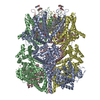 9b6gC 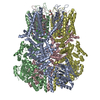 9b6iC 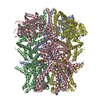 9b6jC 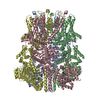 9b6kC M: atomic model generated by this map C: citing same article ( |
|---|---|
| Similar structure data | Similarity search - Function & homology  F&H Search F&H Search |
- Links
Links
| EMDB pages |  EMDB (EBI/PDBe) / EMDB (EBI/PDBe) /  EMDataResource EMDataResource |
|---|
- Map
Map
| File |  Download / File: emd_44259.map.gz / Format: CCP4 / Size: 125 MB / Type: IMAGE STORED AS FLOATING POINT NUMBER (4 BYTES) Download / File: emd_44259.map.gz / Format: CCP4 / Size: 125 MB / Type: IMAGE STORED AS FLOATING POINT NUMBER (4 BYTES) | ||||||||||||||||||||||||||||||||||||
|---|---|---|---|---|---|---|---|---|---|---|---|---|---|---|---|---|---|---|---|---|---|---|---|---|---|---|---|---|---|---|---|---|---|---|---|---|---|
| Annotation | The final full map sharpened with a B factor of -30 | ||||||||||||||||||||||||||||||||||||
| Projections & slices | Image control
Images are generated by Spider. | ||||||||||||||||||||||||||||||||||||
| Voxel size | X=Y=Z: 1.08 Å | ||||||||||||||||||||||||||||||||||||
| Density |
| ||||||||||||||||||||||||||||||||||||
| Symmetry | Space group: 1 | ||||||||||||||||||||||||||||||||||||
| Details | EMDB XML:
|
-Supplemental data
-Half map: Half map A of the final 3D reconstruction
| File | emd_44259_half_map_1.map | ||||||||||||
|---|---|---|---|---|---|---|---|---|---|---|---|---|---|
| Annotation | Half map A of the final 3D reconstruction | ||||||||||||
| Projections & Slices |
| ||||||||||||
| Density Histograms |
-Half map: Half map B of the final 3D reconstruction
| File | emd_44259_half_map_2.map | ||||||||||||
|---|---|---|---|---|---|---|---|---|---|---|---|---|---|
| Annotation | Half map B of the final 3D reconstruction | ||||||||||||
| Projections & Slices |
| ||||||||||||
| Density Histograms |
- Sample components
Sample components
-Entire : Transient receptor potential cation channel subfamily M member 8
| Entire | Name: Transient receptor potential cation channel subfamily M member 8 |
|---|---|
| Components |
|
-Supramolecule #1: Transient receptor potential cation channel subfamily M member 8
| Supramolecule | Name: Transient receptor potential cation channel subfamily M member 8 type: complex / ID: 1 / Parent: 0 / Macromolecule list: #1 |
|---|---|
| Source (natural) | Organism:  |
-Macromolecule #1: Transient receptor potential cation channel subfamily M member 8
| Macromolecule | Name: Transient receptor potential cation channel subfamily M member 8 type: protein_or_peptide / ID: 1 / Number of copies: 4 / Enantiomer: LEVO |
|---|---|
| Source (natural) | Organism:  |
| Molecular weight | Theoretical: 131.548312 KDa |
| Recombinant expression | Organism:  Homo sapiens (human) Homo sapiens (human) |
| Sequence | String: MASFEGARLS MRSRRNGTMG STRTLYSSVS RSTDVSYSDS DLVNFIQANF KKRECVFFTR DSKAMENICK CGYAQSQHIE GTQINQNEK WNYKKHTKEF PTDAFGDIQF ETLGKKGKYL RLSCDTDSET LYELLTQHWH LKTPNLVISV TGGAKNFALK P RMRKIFSR ...String: MASFEGARLS MRSRRNGTMG STRTLYSSVS RSTDVSYSDS DLVNFIQANF KKRECVFFTR DSKAMENICK CGYAQSQHIE GTQINQNEK WNYKKHTKEF PTDAFGDIQF ETLGKKGKYL RLSCDTDSET LYELLTQHWH LKTPNLVISV TGGAKNFALK P RMRKIFSR LIYIAQSKGA WILTGGTHYG LMKYIGEVVR DNTISRNSEE NIVAIGIAAW GMVSNRDTLI RSCDDEGHFS AQ YIMDDFT RDPLYILDNN HTHLLLVDNG CHGHPTVEAK LRNQLEKYIS ERTSQDSNYG GKIPIVCFAQ GGGRETLKAI NTS VKSKIP CVVVEGSGQI ADVIASLVEV EDVLTSSMVK EKLVRFLPRT VSRLPEEEIE SWIKWLKEIL ESSHLLTVIK MEEA GDEIV SNAISYALYK AFSTNEQDKD NWNGQLKLLL EWNQLDLASD EIFTNDRRWE SADLQEVMFT ALIKDRPKFV RLFLE NGLN LQKFLTNEVL TELFSTHFST LVYRNLQIAK NSYNDALLTF VWKLVANFRR SFWKEDRSSR EDLDVELHDA SLTTRH PLQ ALFIWAILQN KKELSKVIWE QTKGCTLAAL GASKLLKTLA KVKNDINAAG ESEELANEYE TRAVELFTEC YSNDEDL AE QLLVYSCEAW GGSNCLELAV EATDQHFIAQ PGVQNFLSKQ WYGEISRDTK NWKIILCLFI IPLVGCGLVS FRKKPIDK H KKLLWYYVAF FTSPFVVFSW NVVFYIAFLL LFAYVLLMDF HSVPHTPELI LYALVFVLFC DEVRQWYMNG VNYFTDLWN VMDTLGLFYF IAGIVFRLHS SNKSSLYSGR VIFCLDYIIF TLRLIHIFTV SRNLGPKIIM LQRMLIDVFF FLFLFAVWMV AFGVARQGI LRQNEQRWRW IFRSVIYEPY LAMFGQVPSD VDSTTYDFSH CTFSGNESKP LCVELDEHNL PRFPEWITIP L VCIYMLST NILLVNLLVA MFGYTVGIVQ ENNDQVWKFQ RYFLVQEYCN RLNIPFPFVV FAYFYMVVKK CFKCCCKEKN ME SNACCFR NEDNETLAWE GVMKENYLVK INTKANDNSE EMRHRFRQLD SKLNDLKSLL KEIANNIKSN SLEVLFQGPD YKD DDDKAH HHHHHHHHH UniProtKB: Transient receptor potential cation channel subfamily M member 8 |
-Macromolecule #2: 3-{7-(trifluoromethyl)-5-[2-(trifluoromethyl)phenyl]-1H-benzimida...
| Macromolecule | Name: 3-{7-(trifluoromethyl)-5-[2-(trifluoromethyl)phenyl]-1H-benzimidazol-2-yl}-1-oxa-2-azaspiro[4.5]dec-2-ene type: ligand / ID: 2 / Number of copies: 4 / Formula: T14 |
|---|---|
| Molecular weight | Theoretical: 467.407 Da |
| Chemical component information | 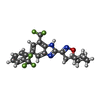 ChemComp-T14: |
-Macromolecule #3: CHOLESTEROL HEMISUCCINATE
| Macromolecule | Name: CHOLESTEROL HEMISUCCINATE / type: ligand / ID: 3 / Number of copies: 12 / Formula: Y01 |
|---|---|
| Molecular weight | Theoretical: 486.726 Da |
| Chemical component information |  ChemComp-Y01: |
-Macromolecule #4: nonyl(oxo)di(propan-2-yl)-lambda~5~-phosphane
| Macromolecule | Name: nonyl(oxo)di(propan-2-yl)-lambda~5~-phosphane / type: ligand / ID: 4 / Number of copies: 4 / Formula: ULO |
|---|---|
| Molecular weight | Theoretical: 260.396 Da |
| Chemical component information |  ChemComp-ULO: |
-Macromolecule #5: 2-acetamido-2-deoxy-beta-D-glucopyranose
| Macromolecule | Name: 2-acetamido-2-deoxy-beta-D-glucopyranose / type: ligand / ID: 5 / Number of copies: 4 / Formula: NAG |
|---|---|
| Molecular weight | Theoretical: 221.208 Da |
| Chemical component information |  ChemComp-NAG: |
-Experimental details
-Structure determination
| Method | cryo EM |
|---|---|
 Processing Processing | single particle reconstruction |
| Aggregation state | particle |
- Sample preparation
Sample preparation
| Buffer | pH: 8 |
|---|---|
| Grid | Model: Quantifoil R1.2/1.3 / Material: COPPER / Mesh: 300 / Support film - Material: CARBON / Support film - topology: CONTINUOUS / Support film - Film thickness: 2 / Pretreatment - Type: GLOW DISCHARGE |
| Vitrification | Cryogen name: ETHANE / Chamber humidity: 100 % / Chamber temperature: 293.15 K / Instrument: FEI VITROBOT MARK IV |
- Electron microscopy
Electron microscopy
| Microscope | FEI TITAN KRIOS |
|---|---|
| Specialist optics | Energy filter - Name: GIF Bioquantum / Energy filter - Slit width: 20 eV |
| Image recording | Film or detector model: GATAN K3 BIOQUANTUM (6k x 4k) / Number grids imaged: 1 / Number real images: 14226 / Average electron dose: 60.0 e/Å2 |
| Electron beam | Acceleration voltage: 300 kV / Electron source:  FIELD EMISSION GUN FIELD EMISSION GUN |
| Electron optics | Illumination mode: FLOOD BEAM / Imaging mode: BRIGHT FIELD / Cs: 2.7 mm / Nominal defocus max: 2.2 µm / Nominal defocus min: 0.7000000000000001 µm / Nominal magnification: 81000 |
| Sample stage | Specimen holder model: FEI TITAN KRIOS AUTOGRID HOLDER / Cooling holder cryogen: NITROGEN |
| Experimental equipment |  Model: Titan Krios / Image courtesy: FEI Company |
+ Image processing
Image processing
-Atomic model buiding 1
| Initial model | Chain - Source name: Other / Chain - Initial model type: experimental model Details: Another structural model from this study was used as the initial model for model building. |
|---|---|
| Refinement | Space: REAL / Protocol: RIGID BODY FIT |
| Output model |  PDB-9b6h: |
 Movie
Movie Controller
Controller










 Z (Sec.)
Z (Sec.) Y (Row.)
Y (Row.) X (Col.)
X (Col.)






































